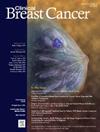低剂量他莫昔芬预防乳腺癌:现实世界的经验。
IF 2.9
3区 医学
Q2 ONCOLOGY
引用次数: 0
摘要
目的:自2019年引入低剂量他莫昔芬(LDT)用于化学预防以来,有关其使用的数据有限。本研究旨在确定我们机构的LDT吸收率,并描述与其使用相关的因素。方法:我们对2019年至2021年诊断为导管原位癌(DCIS)、小叶原位癌(LCIS)和/或非典型增生的女性进行了回顾性图表回顾。采用对数二项模型比较患者和疾病特征接受标准剂量他莫昔芬(SDT)相对于LDT的概率。由于大多数患者没有发生任何不良事件,因此使用零膨胀毒性回归模型来估计和比较组间的不良事件发生率。结果:在477例DCIS、LCIS和非典型增生患者中,27% (N = 129)开始使用SDT, 19% (N = 89)使用LDT, 32% (N = 155)使用芳香化酶抑制剂,2% (N = 9)使用雷洛昔芬,20% (N = 95)拒绝治疗。与DCIS相比,LCIS或非典型增生患者使用LDT的频率高于SDT (31.4% vs 17.4%, P < 0.0001)。SDT组和LDT组不良事件发生频率无显著差异,但SDT组不良事件发生率更高(每1000天1.9 vs 1.3, P = 0.0186)。结论:在我们的人群中,19%患有DCIS、LCIS或非典型增生的女性开始使用LDT进行化学预防,在非典型病变和/或LCIS患者中使用LDT的比例更高。医生应强烈考虑对有高危病变的妇女进行LDT,这些妇女有资格进行化学预防。本文章由计算机程序翻译,如有差异,请以英文原文为准。
Low Dose Tamoxifen for Breast Cancer Prevention: A Real-World Experience
Purpose
There is limited data on the use of low dose tamoxifen (LDT) for chemoprevention since its introduction in 2019. This study sought to determine the rate of LDT uptake at our institution and describe factors associated with its use.
Methods
We performed a retrospective chart review of women diagnosed with ductal carcinoma in situ (DCIS), lobular carcinoma in situ (LCIS), and/or atypical hyperplasia from 2019 to 2021. Log-binomial models were used to compare the probabilities of receiving standard dose tamoxifen (SDT) relative to LDT by patient and disease characteristics. Since most patients did not experience any AEs, a zero-inflated poison regression model was used to estimate and compare adverse event rates between groups.
Results
Among 477 patients with DCIS, LCIS, and atypical hyperplasia, 27% (N = 129) initiated SDT, 19% (N = 89) LDT, 32% (N = 155) aromatase inhibitor, 2% (N = 9) raloxifene, and 20% (N = 95) declined therapy. LDT was used more frequently than SDT in patients with LCIS or atypical hyperplasia compared to DCIS (31.4% vs 17.4%, P < .0001). There were no significant differences in the frequency of adverse events between patients on SDT and LDT but the incidence rate of AEs in the SDT group was higher (1.9 vs. 1.3 per 1000 days, P = .0186).
Conclusion
In our population, 19% of women with DCIS, LCIS, or atypical hyperplasia, initiated chemoprevention with LDT with higher usage in patients with atypical lesions and/or LCIS. Physicians should strongly consider LDT in women with high-risk lesions who are eligible for chemoprevention.
求助全文
通过发布文献求助,成功后即可免费获取论文全文。
去求助
来源期刊

Clinical breast cancer
医学-肿瘤学
CiteScore
5.40
自引率
3.20%
发文量
174
审稿时长
48 days
期刊介绍:
Clinical Breast Cancer is a peer-reviewed bimonthly journal that publishes original articles describing various aspects of clinical and translational research of breast cancer. Clinical Breast Cancer is devoted to articles on detection, diagnosis, prevention, and treatment of breast cancer. The main emphasis is on recent scientific developments in all areas related to breast cancer. Specific areas of interest include clinical research reports from various therapeutic modalities, cancer genetics, drug sensitivity and resistance, novel imaging, tumor genomics, biomarkers, and chemoprevention strategies.
 求助内容:
求助内容: 应助结果提醒方式:
应助结果提醒方式:


